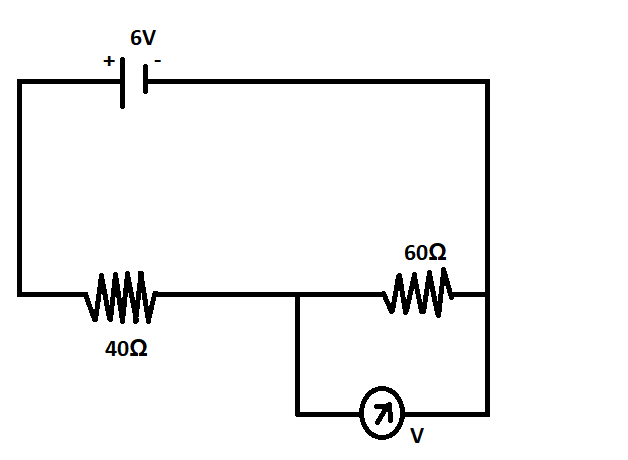
The reading of the voltmeter in the circuit shown is:

A. $3.6V$
B. $3.25V$
C. $2.25V$
D. $6.25V$

Answer
559.5k+ views
Hint: In the question, we are not given the internal resistance of the circuit. In such a case we have to assume that the internal resistance of the voltmeter is infinite. We can calculate the current in the circuit using Kirchoff’s law. Now we can calculate the potential difference using Ohm’s law. According to Ohm’s law, the current through a conductor can be obtained by taking the ratio of potential difference to the current.
Formula used:
Ohm’s law
$V = iR$ Where $V$stands for the potential difference, $i$stands for the current and $R$stands for the resistance of the circuit.
Complete step by step answer:
Let us assume that the internal resistance of the voltmeter is infinite. So the current will not flow through the voltmeter.
Now we have to apply Kirchhoff's second law to the circuit.
Kirchhoff’s second law states that the algebraic sum of the product of resistance and current in each branch of any closed circuit is equal to the algebraic sum of the e.m.fs in that closed circuit.
Now we can write the Kirchhoff’s law for the given circuit as,
$6V - 40i - 60i = 0$
From this, we can write the current as,
$i = \dfrac{6}{{100}} = 0.06A$
By applying Ohm’s law, we get the voltage across the $60\Omega $ resistor as,
$\Delta V = iR = 0.06 \times 60 = 3.6V$
This will be the reading across the voltmeter since the potential difference between the $60\Omega $ resistor and the voltmeter will be the same.
So, the correct answer is “Option A”.
Note:
To solve this circuit, we can use another method where we have to find the equivalent resistance of the circuit. Using Ohm’s law we can find the current through the voltmeter and thus we can find the voltage through the voltmeter. In a series combination of resistors, the equivalent resistance of a number of resistors in series is the sum of individual resistances of the individual resistors. The effective resistance is higher than the highest value of resistance in the combination. The series combination of resistors can be used to increase the effective resistance of the circuit. In a parallel combination, the potential difference across each resistor will be the same. In parallel combination, the reciprocal of the effective resistance is equal to the sum of the reciprocals of the individual resistances.
Formula used:
Ohm’s law
$V = iR$ Where $V$stands for the potential difference, $i$stands for the current and $R$stands for the resistance of the circuit.
Complete step by step answer:
Let us assume that the internal resistance of the voltmeter is infinite. So the current will not flow through the voltmeter.
Now we have to apply Kirchhoff's second law to the circuit.
Kirchhoff’s second law states that the algebraic sum of the product of resistance and current in each branch of any closed circuit is equal to the algebraic sum of the e.m.fs in that closed circuit.
Now we can write the Kirchhoff’s law for the given circuit as,
$6V - 40i - 60i = 0$
From this, we can write the current as,
$i = \dfrac{6}{{100}} = 0.06A$
By applying Ohm’s law, we get the voltage across the $60\Omega $ resistor as,
$\Delta V = iR = 0.06 \times 60 = 3.6V$
This will be the reading across the voltmeter since the potential difference between the $60\Omega $ resistor and the voltmeter will be the same.
So, the correct answer is “Option A”.
Note:
To solve this circuit, we can use another method where we have to find the equivalent resistance of the circuit. Using Ohm’s law we can find the current through the voltmeter and thus we can find the voltage through the voltmeter. In a series combination of resistors, the equivalent resistance of a number of resistors in series is the sum of individual resistances of the individual resistors. The effective resistance is higher than the highest value of resistance in the combination. The series combination of resistors can be used to increase the effective resistance of the circuit. In a parallel combination, the potential difference across each resistor will be the same. In parallel combination, the reciprocal of the effective resistance is equal to the sum of the reciprocals of the individual resistances.
Recently Updated Pages
A man running at a speed 5 ms is viewed in the side class 12 physics CBSE

The number of solutions in x in 02pi for which sqrt class 12 maths CBSE

State and explain Hardy Weinbergs Principle class 12 biology CBSE

Write any two methods of preparation of phenol Give class 12 chemistry CBSE

Which of the following statements is wrong a Amnion class 12 biology CBSE

Differentiate between action potential and resting class 12 biology CBSE

Trending doubts
What are the major means of transport Explain each class 12 social science CBSE

Which are the Top 10 Largest Countries of the World?

Draw a labelled sketch of the human eye class 12 physics CBSE

Explain sex determination in humans with line diag class 12 biology CBSE

Explain sex determination in humans with the help of class 12 biology CBSE

Differentiate between homogeneous and heterogeneous class 12 chemistry CBSE




